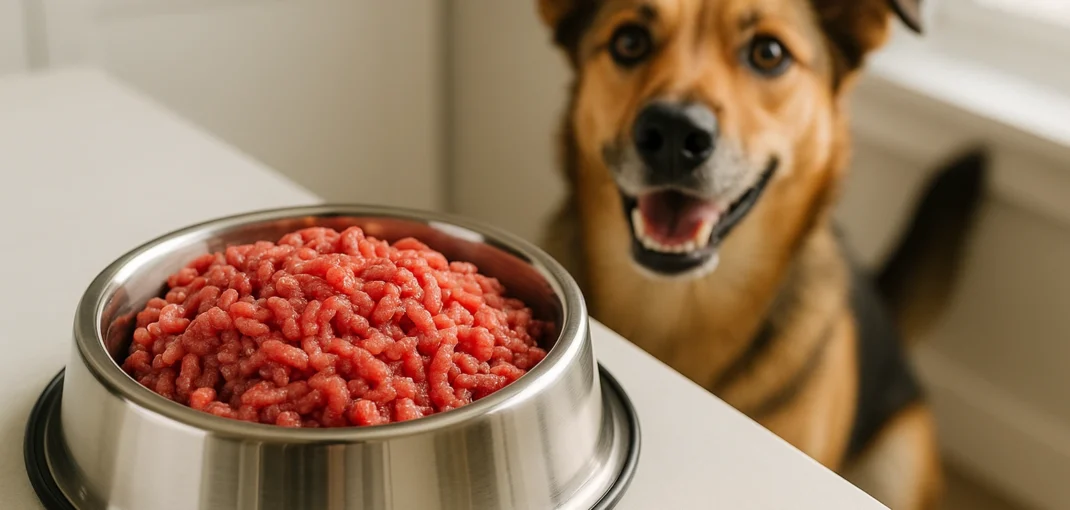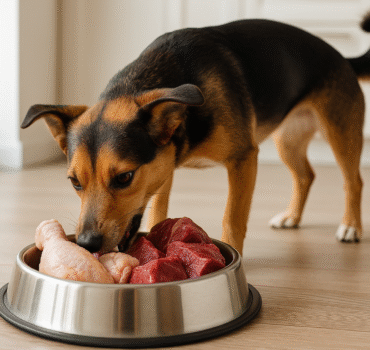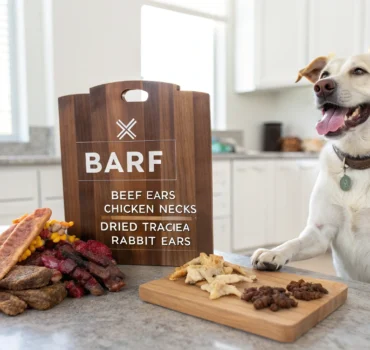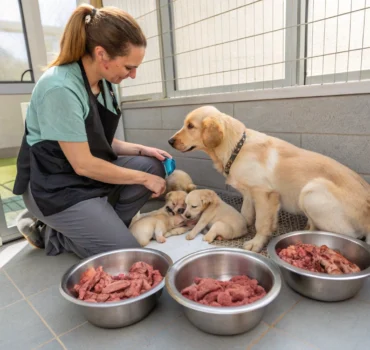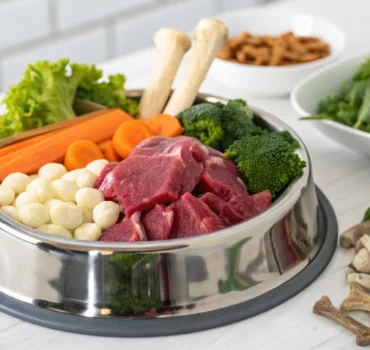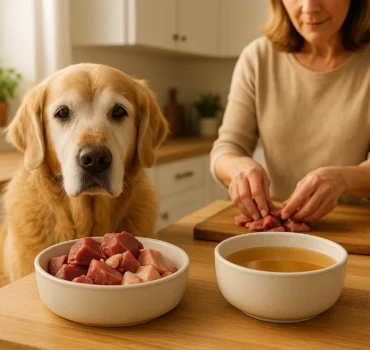The Convenient Way to Feed Your Dog Naturally
Thinking about switching your dog to raw food but worried about the mess and complexity? Raw mince dog food might be your perfect solution.
Raw mince offers all the benefits of raw feeding without the hassle of cutting meat or dealing with large bones. It’s pre-ground, easy to portion, and simple to serve. Perfect for busy dog owners who want to feed naturally but don’t have hours to spend preparing meals.
Many people assume raw feeding means giving their dog whole chickens or massive beef bones. But raw mince makes the process much more manageable, especially if you’re new to raw feeding or have a small dog.
In this guide, you’ll discover what raw mince dog food is, how it compares to other raw feeding methods, and how to use it to give your dog optimal nutrition. Whether you’re completely new to raw feeding or looking for a more convenient approach, this article has everything you need.
What Is Raw Mince Dog Food?
Raw mince dog food is ground raw meat, often mixed with bone and organs, that’s ready to feed straight from the package. Think of it like ground beef you’d buy for yourself, but formulated specifically for dogs.
The best raw mince products include muscle meat, ground bone for calcium, and organ meats for vitamins and minerals. Everything is ground together into a consistent texture that’s easy for dogs to eat and digest.
Some raw mince is single-ingredient, like pure ground chicken or beef. Others are complete meals with multiple ingredients balanced to provide full nutrition. Both types have their place depending on your feeding goals.
The grinding process makes raw mince especially suitable for certain situations. Small dogs can eat it easily without struggling with large pieces. Senior dogs with dental issues can manage it better than chunks. Picky eaters often prefer the texture.
Raw mince also works great for training treats. You can portion out small amounts, freeze them in ice cube trays, and have ready-made training rewards that are healthier than processed treats.
At Yummy Dog Food, we offer several complete raw mince options including our Special Beef Recipe, Special Chicken Recipe, Special Lamb Recipe, and Turkey Recipe. Each is formulated to provide complete, balanced nutrition in an easy-to-serve format.
Benefits of Feeding Raw Mince Dog Food
Raw mince dog food offers unique advantages that make it appealing to many dog owners. Here’s what makes it special:
Convenience: This is the biggest draw. No cutting, no chopping, no dealing with bones. Just thaw, portion, and serve. Perfect for busy mornings or when you’re short on time.
Portion Control: Raw mince is easy to measure accurately. You can weigh exact amounts to ensure your dog gets the right calories. This helps with weight management.
Complete Nutrition: Quality raw mince products include everything your dog needs in one package. Muscle meat, bone, organs, and sometimes vegetables all ground together.
Easy Transition: Dogs switching from kibble often accept raw mince more readily than chunks or whole pieces. The familiar texture makes the change less dramatic.
Versatile Use: You can serve raw mince as complete meals, mix it with other foods, use it for training treats, or stuff it into puzzle toys for enrichment.
Small Dog Friendly: Tiny breeds can struggle with large raw pieces. Raw mince gives them all the benefits of raw feeding in a size they can handle.
Senior Dog Suitable: Older dogs with missing teeth or dental problems can eat raw mince comfortably. They don’t miss out on raw nutrition just because they can’t crunch bones anymore.
Freezer Friendly: Raw mince freezes well and thaws quickly. You can buy in bulk, freeze in portions, and always have meals ready.
Less Mess: Compared to feeding whole pieces or raw meaty bones, mince is relatively tidy. Less cleanup means more time enjoying your dog.
These benefits make raw mince dog food an excellent choice for many households, especially those new to raw feeding.
Raw Mince vs Other Raw Feeding Methods
Understanding how raw mince fits into the raw feeding world helps you make informed decisions. Here’s how it compares:
Raw Mince vs Whole Prey: Whole prey feeding involves giving entire animals like rabbits or chickens. It’s the most natural but also the messiest and most expensive. Raw mince offers similar nutrition with far more convenience.
Raw Mince vs Raw Cut: Raw cut feeding uses chunks and pieces of meat with bone. It provides more dental benefits through chewing but requires more preparation. Raw mince is easier but offers less teeth-cleaning action.
Raw Mince vs DIY Ground: Some people grind their own raw food at home. This gives complete control over ingredients but requires equipment and time. Pre-made raw mince saves effort while still providing quality nutrition.
Raw Mince vs Kibble: Kibble is highly processed and cooked at high temperatures. Raw mince retains natural enzymes, nutrients, and moisture that cooking destroys. Dogs typically digest raw mince better than kibble.
Raw Mince vs Freeze-Dried Raw: Freeze-dried raw is convenient and shelf-stable but expensive. Raw mince costs less and provides the same nutritional benefits with the added bonus of natural moisture.
Each method has its place. Many dog owners use a combination approach. They might feed raw mince for breakfast and raw meaty bones for dinner, getting the benefits of both.
The key is finding what works for your lifestyle, budget, and dog’s needs. Raw mince dog food often strikes the perfect balance between convenience and nutrition.
How to Choose Quality Raw Mince Dog Food
Not all raw mince is created equal. Here’s what to look for when selecting products:
Complete vs Complementary: Complete raw mince includes meat, bone, organs, and sometimes vegetables in balanced ratios. Complementary mince is just meat and needs other ingredients added. Make sure you know which you’re buying.
Ingredient Quality: Look for human-grade meat from reputable sources. Avoid products with vague terms like “meat meal” or “animal derivatives.” You should see real ingredients listed clearly.
Bone Content: Quality raw mince includes ground bone for calcium. Check that bone is listed in the ingredients. Without it, you’ll need to supplement calcium separately.
Organ Inclusion: Liver, kidney, and other organs provide essential vitamins. Good raw mince products include about 10% organ meat.
No Additives: The ingredient list should be short and recognizable. Avoid products with preservatives, artificial colors, or unnecessary fillers.
Proper Packaging: Raw mince should come frozen or vacuum-sealed. Proper packaging prevents freezer burn and maintains freshness.
Clear Feeding Guidelines: Reputable brands provide feeding instructions based on dog weight and activity level. This helps you portion correctly.
Variety Options: Look for brands offering multiple protein sources. Rotating between chicken, beef, lamb, and other proteins provides nutritional variety.
At Yummy Dog Food, our raw mince products meet all these criteria. Our Special Beef Recipe and Special Lamb Recipe are complete meals with proper bone and organ content. For dogs needing simpler options, our Simple Chicken Recipe provides quality protein at an affordable price.
Getting Started With Raw Mince Dog Food
Ready to try raw mince? Here’s your step-by-step guide to starting successfully:
Calculate Daily Amount: Adult dogs typically need 2-3% of their body weight in food daily. A 10kg dog would eat 200-300 grams per day. Adjust based on activity level and body condition.
Choose Your First Protein: Start with a single protein source for the first week. Chicken is usually easiest to digest and most affordable. Our Special Chicken Recipe is perfect for beginners.
Transition Gradually: Don’t switch from kibble to raw overnight. Start with 25% raw mince and 75% kibble. Every few days, increase raw and decrease kibble until you’re feeding 100% raw. This usually takes 7-10 days.
Thaw Properly: Move frozen raw mince to the refrigerator 12-24 hours before feeding. Never thaw on the counter. Use thawed food within 2-3 days.
Serve at Room Temperature: Take raw mince out of the fridge 15-30 minutes before feeding. Room temperature food is easier to digest and more appealing to dogs.
Monitor Response: Watch your dog’s stools, energy levels, and coat condition. Healthy stools should be firm and smaller than on kibble. Energy should increase, and coat should become shinier over a few weeks.
Add Variety: Once your dog adjusts to chicken, introduce other proteins. Try beef, lamb, or turkey. Rotate proteins weekly or even daily for nutritional variety.
Keep It Simple: Don’t overthink it. Feed the recommended amount, provide fresh water, and let your dog’s body do what it’s designed to do.
Most dogs transition to raw mince dog food without any issues. The key is patience and observation.
Feeding Guidelines and Portion Sizes
Getting portions right ensures your dog maintains a healthy weight and gets proper nutrition. Here’s how to calculate and adjust:
Basic Formula: Start with 2-3% of adult body weight daily. Active dogs need closer to 3%, while less active dogs do better at 2%.
Puppy Portions: Growing puppies need more. Feed 5-10% of their current body weight, divided into 3-4 meals daily. Adjust as they grow.
Senior Dogs: Older, less active dogs often need slightly less. Start at 2% and adjust based on body condition.
Weight Loss: If your dog needs to lose weight, feed 2% of their ideal weight, not current weight. Monitor progress and adjust.
Weight Gain: Underweight dogs may need 3-4% of body weight. Increase gradually and monitor.
Meal Frequency: Adult dogs can eat once or twice daily. Puppies need more frequent meals. Large breed dogs often do better with two smaller meals to prevent bloat.
Seasonal Adjustments: Dogs may need more food in winter and less in summer. Pay attention to body condition and adjust accordingly.
Example Portions:
- 5kg dog: 100-150g daily
- 10kg dog: 200-300g daily
- 20kg dog: 400-600g daily
- 30kg dog: 600-900g daily
These are starting points. Every dog is different. The best indicator is body condition. You should be able to feel your dog’s ribs easily but not see them prominently.
Our products at Yummy Dog Food come in convenient 1kg packages, making portioning simple. A 1kg package of our Special Beef Recipe provides 2-5 days of food depending on your dog’s size.
Mixing Raw Mince With Other Foods
Raw mince dog food is versatile. You can feed it alone or combine it with other ingredients for variety and additional benefits:
With Raw Meaty Bones: Feed raw mince for one meal and raw meaty bones like chicken necks or chicken wings for another. This provides dental benefits while keeping meals convenient.
With Vegetables: Add small amounts of pureed vegetables like carrots, spinach, or pumpkin. Keep vegetables under 10% of the meal. This adds fiber and extra nutrients.
With Raw Eggs: Crack a raw egg over the mince once or twice weekly. Eggs provide excellent protein and healthy fats.
With Fish Oil: Add a pump of fish oil for omega-3 fatty acids. This supports skin, coat, and joint health.
With Natural Treats: Use our beef ears or beef lung as snacks between meals for additional chewing satisfaction.
With Bone Broth: Pour homemade bone broth over raw mince for extra flavor and joint-supporting nutrients.
Rotation Feeding: Alternate between different proteins throughout the week. Monday and Tuesday chicken, Wednesday and Thursday beef, Friday and Saturday lamb. This ensures varied nutrition.
Partial Raw Feeding: If budget or lifestyle doesn’t allow full raw feeding, even feeding raw mince for one meal daily while keeping kibble for the other meal provides benefits.
The beauty of raw mince is its flexibility. You can keep it simple or get creative based on your time and interest.
Storage and Food Safety Tips
Handling raw mince dog food safely protects both you and your dog. Follow these practices:
Freezer Storage: Keep unopened raw mince frozen at 0°F or below. It stays good for 6-12 months in the freezer.
Refrigerator Storage: Once thawed, store in the refrigerator and use within 2-3 days. Keep in sealed containers to prevent cross-contamination.
Thawing Method: Always thaw in the refrigerator, never on the counter. For faster thawing, place sealed package in cold water, changing water every 30 minutes.
Portion Before Freezing: Divide large packages into daily portions before freezing. This makes thawing easier and prevents waste.
Clean Bowls: Wash your dog’s bowl with hot, soapy water after each meal. Don’t let raw food sit out for hours.
Hand Hygiene: Wash hands thoroughly before and after handling raw mince. Use soap and warm water for at least 20 seconds.
Separate Surfaces: Use different cutting boards and utensils for dog food and human food. Or sanitize thoroughly between uses.
Feeding Area: Feed in an easy-to-clean area. Wipe up any spills immediately. Some people feed outside or in the bathroom for easier cleanup.
Watch for Spoilage: If raw mince smells off, looks discolored, or has been thawed too long, throw it out. Better safe than sorry.
Pet Safety: Healthy dogs handle bacteria in raw meat well. Their digestive systems are designed for it. Still, practice good hygiene to protect yourself and any vulnerable family members.
These practices become routine quickly. Most raw feeders find that safety concerns were overblown and that common sense is sufficient.
Common Questions and Concerns
New raw feeders often have similar questions about raw mince dog food. Here are the answers:
Is it messy? Raw mince is one of the tidiest raw feeding options. It’s much less messy than whole bones or large meat chunks. Use a bowl and feed in an easy-to-clean area.
Will my dog choke? No. Raw mince is ground to a safe consistency. Dogs can eat it easily without choking risk.
What about bacteria? Dogs have highly acidic stomachs that kill most bacteria. Salmonella and E. coli that make humans sick rarely affect healthy dogs eating raw food.
Do I need supplements? If you’re feeding complete raw mince that includes bone and organs, you typically don’t need supplements. Incomplete mince may require calcium and other additions.
Can puppies eat it? Yes. Puppies can start eating raw mince as early as 4 weeks old. It’s actually excellent for growing dogs.
What about dental health? Raw mince doesn’t provide as much teeth-cleaning action as raw meaty bones. Consider adding bones a few times weekly for dental benefits.
Is it expensive? Quality raw mince costs more than cheap kibble but is comparable to premium kibble. At Yummy Dog Food, our complete meals range from €3.50 to €6.50 per kilogram, making raw feeding affordable.
Can I travel with it? Raw mince requires freezing or refrigeration, making travel challenging. Consider freeze-dried raw or high-quality kibble for trips.
Most concerns disappear once you start feeding raw mince and see how simple and beneficial it is.
Conclusion: Simplify Raw Feeding With Quality Mince
Raw mince dog food offers the perfect entry point into natural feeding. It provides all the benefits of raw nutrition without the complexity or mess that intimidates many dog owners.
Your dog deserves real food, not processed kibble filled with grains and additives. Raw mince gives them species-appropriate nutrition in a convenient, easy-to-serve format.
Whether you’re feeding a tiny Chihuahua or a large German Shepherd, raw mince works. It’s versatile, nutritious, and practical for modern life.
The results speak for themselves. Shinier coats, better digestion, more energy, and healthier dogs overall. These improvements happen within weeks of switching.
Ready to give your dog the nutrition they deserve? Visit Yummy Dog Food and explore our complete range of raw mince options. Try our Special Chicken Recipe for an affordable introduction to raw feeding, or choose our Turkey Recipe for puppies and cats. We deliver across Cyprus, bringing quality raw nutrition right to your door. Your dog’s health is worth it.
Frequently Asked Questions
Can I mix raw mince dog food with kibble in the same meal?
While many people do this successfully, it’s not ideal. Raw food and kibble digest at different rates, which can cause digestive upset in some dogs. If you want to feed both, it’s better to give them at separate meals (raw in the morning, kibble at night). However, if your dog handles mixed meals without issues, it’s fine to continue. The most important thing is that your dog is eating well and staying healthy.
How long does raw mince dog food last once opened?
Once thawed, raw mince should be used within 2-3 days when stored properly in the refrigerator. If you’ve opened a large package, portion out what you’ll use in that timeframe and refreeze the rest immediately. Refrozen raw mince maintains quality, though some nutrients may degrade slightly. Always smell and inspect the food before serving. If it looks or smells off, discard it.
Is raw mince dog food suitable for dogs with allergies?
Yes, raw mince can be excellent for dogs with food sensitivities. The key is choosing proteins your dog tolerates well. If your dog is allergic to chicken, try beef, lamb, or turkey mince instead. Single-protein raw mince products make it easy to identify and avoid problem ingredients. Many dogs with chronic allergies on kibble improve dramatically when switched to raw mince because you control exactly what goes into their bowl. Always introduce new proteins gradually and monitor for reactions.
